2014 AUDI RS7 SPORTBACK winter tires
[x] Cancel search: winter tiresPage 81 of 292
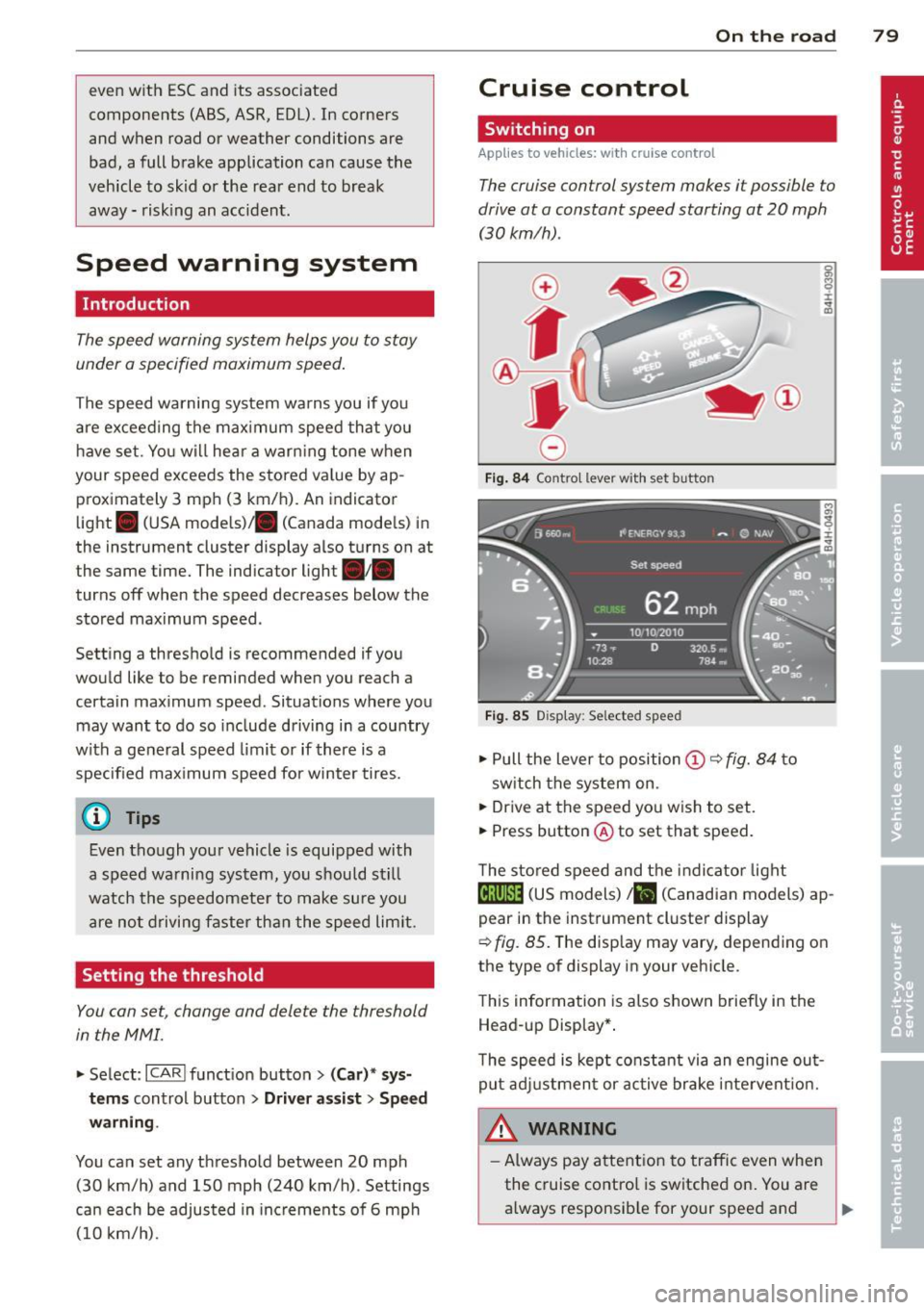
even with ESC and its associated
components (ABS, ASR, EDL). In corners
and when road or weather conditions are
bad, a full brake application can cause the
vehicle to skid or the rear end to break
away· risking an accident.
Speed warning system
Introduction
The speed warning system helps you to stay
under a specified maximum speed.
The speed warning system wa rns you if you
are exceeding the maximum speed that you
have set. You will hear a warn ing tone when
your speed exceeds the stored value by ap
proximately 3 mph (3 km/h). An indicator
light . (USA models)/ . (Canada models) in
the instrument cluster display also turns on at
the same time. The indicator light ••
turns off when the speed decreases below the
stored maximum speed .
Setting a threshold is recommended if you
would like to be reminded when you reach a certain max imum speed . Situations where you
may want to do so include driving in a country
with a general speed limit or if there is a
specified maximum speed for winter tires.
@ Tips
Even though your vehicle is equipped with
a speed warning system, you should st ill
watch the speedometer to make sure you
are not driving faster than the speed limit.
Setting the threshold
You can set, change and delete the threshold
in the MMI.
.. Se lect : I CARI function button > (Car)* sys
tems
control button > Driver assist > Speed
warning .
You can set any threshold between 20 mph
(30 km/h) and lS0 mph (240 km/h) . Settings
can each be adjusted in inc rements of 6 mph
(10 km/h).
On the road 79
Cruise control
Switching on
Applies to veh icles: w ith cruise control
The cruise control system makes it possible to
drive at a constant speed starting at 20 mph (30km/h) .
0
f
®t
0
Fig. 84 Contro l lever w ith set b utto n
Fig. 85 Display: Se lected speed
.. Pull the lever to position@¢ fig. 84 to
sw itch the system on .
.. Drive at the speed you wish to set.
.. Press button @ to set that speed.
T he stored speed and the indicator light
@;\1)~14 (US models) Iii (Canadian models) ap
pear in the instrument cluster display
¢
fig. 85. The disp lay may vary, depending on
the type of display in your veh icle.
This information is also shown briefly in the
Head -up Display*.
T he speed is kept constant via an engine out
put adjustment or active brake intervent ion.
A WARNING .c
- Always pay attention to traffic even when
the cruise control is switched on. You are always responsib le for your speed and ...
Page 197 of 292
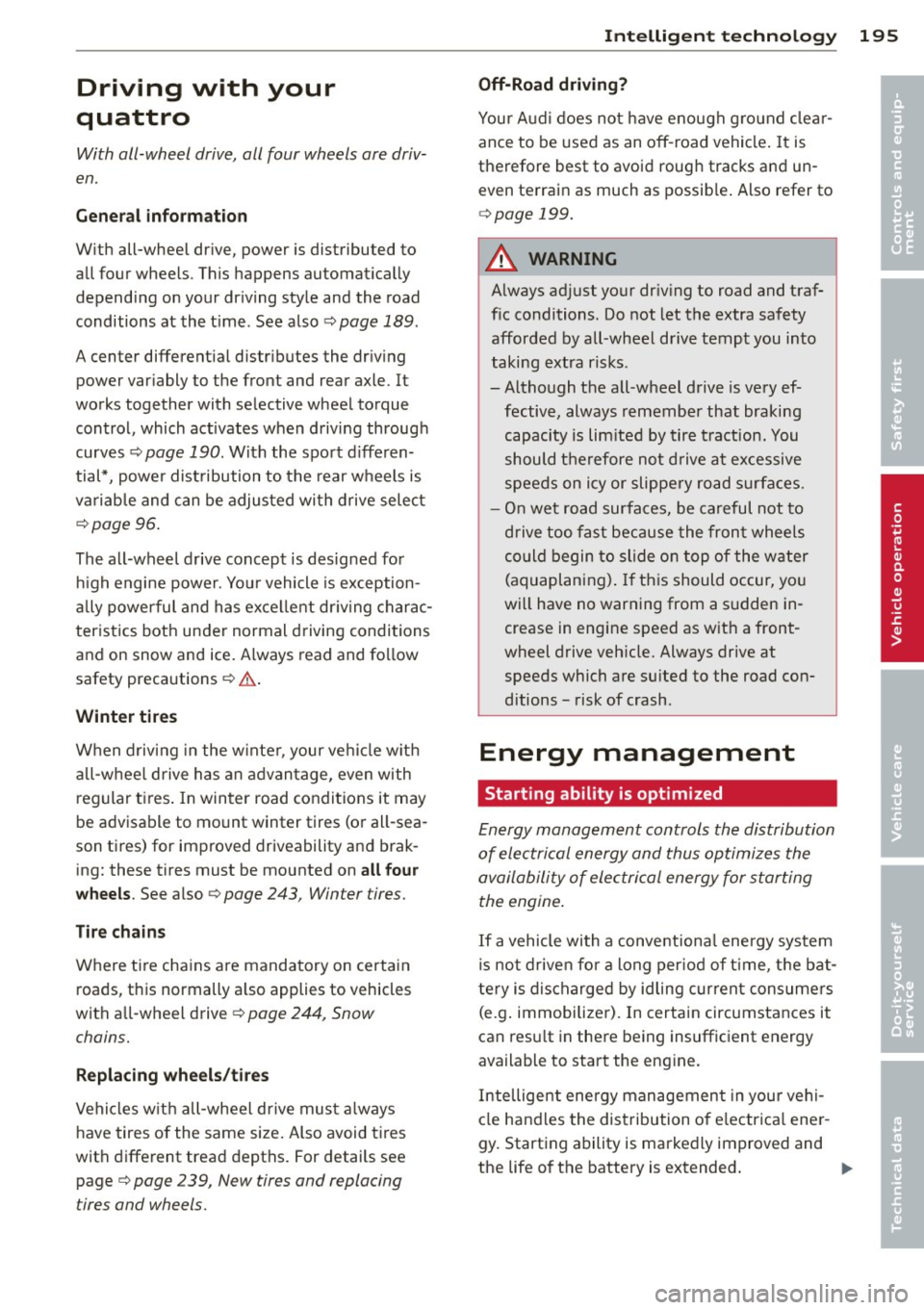
Driving with your
quattro
With all-wheel drive, all four wheels are driv
en .
General information
With all-wheel drive, power is distributed to
all four wheels . This happens automatically
depending on your driving style and the road
conditions at the time . See also
t::;> page 189.
A center differential distributes the driving
power variably to the front and rear axle. It
works together with selective wheel torque
control, which activates when driving through
curves
t::;> page 190 . With the sport d ifferen
tial*, power distribution to the rear wheels is
va riable and can be adjusted with drive select
¢page 96.
The all-wheel drive concept is designed for
hi gh engine power. Your vehicle is exception
ally powerful and has exce llent dr iv ing charac
teristics both under normal driving conditions
and on snow and
ice. Always read and follow
safety precautions
t::;> .& .
Winter tires
When driving in the w inter, your ve hicle with
all-wheel drive has an advantage, even with
regular tires. In winter road conditions it may
be advisable to mount winter tires (or all-sea
son t ires) for improved driveability and brak
ing: these tires must be mounted on
all four
wheels. See also ¢ page 243, Winter tires.
Tire chains
Where tire chains are mandatory on certain
roads, this normally a lso applies to vehicles
with a ll-wheel drive¢
page 244, Snow
chains.
Replacing wheels/tires
Vehicles w ith all-wheel drive must always
have tires of the same size. Also avoid tires
with different tread depths. For details see
page
t::;> page 239, New tires and replacing
tires and wheels .
Intelligent technology 195
Off•Road driving?
Your Audi does not have enough g round clear
ance to be used as an off-road vehicle.
It is
therefore best to avoid rough tracks and un
even terrain as much as possible. Also refer to
¢page 199.
A WARNING
Always adjust your dr iv ing to road and traf
fic conditions. Do not let the extra safety
afforded by all-wheel drive tempt you into
taking extra risks.
- Although the all-wheel drive is very ef fective, always remember that braking
capacity is lim ited by tire traction. You
should therefore not drive at excessive
speeds on icy or slippery road surfaces.
- On wet road surfaces, be careful not to
drive too fast because the front wheels
could begin to slide on top of the water
(aquaplaning) . If this should occur, you
will have no warning from a sudden in
crease in engine speed as with a front
wheel drive veh icle. Always drive at
speeds which are su ited to the road con
ditions - risk of crash.
Energy management
Starting ability is optimized
Energy management controls the distribution
of electrical energy and thus optimizes the
availability of electrical energy for starting
the engine .
If a vehicle with a conventiona l energy system
is not driven for a long period of tim e, the bat
tery is discharged by idling current consumers
(e.g . immobilizer). In certain circumstances it
can resu lt in there being insufficient energy
available to start the eng ine.
Intelligent energy management in your vehi
cle handles the distribution of e lectrica l ene r
gy. Starting ability is markedly improved and
the life of the battery is extended .
ll>
•
•
Page 231 of 292
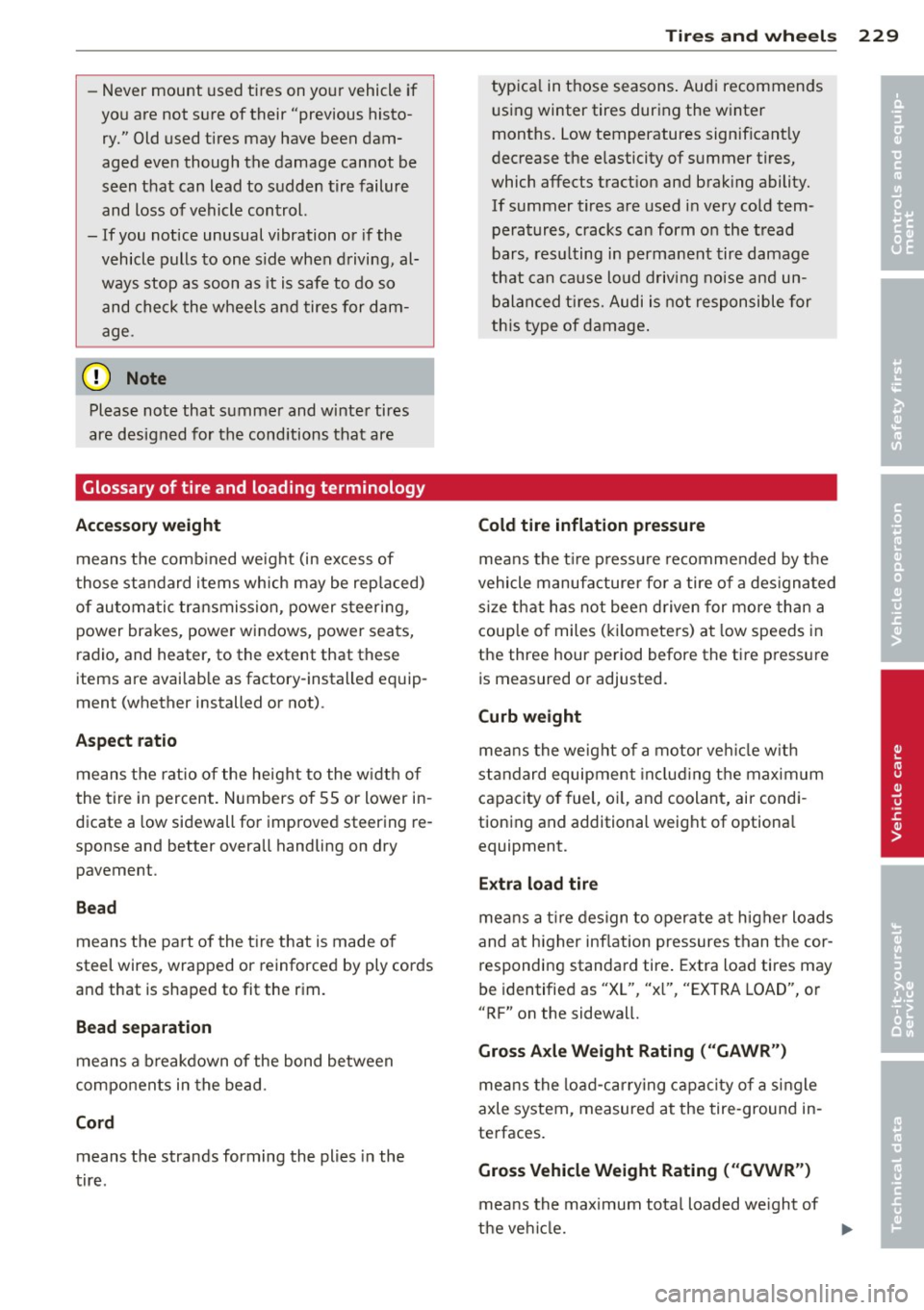
-Never mount used tires on yo ur vehicle if
yo u are not sure of their "previous histo
ry." Old used tires may have been dam
aged even though the damage cannot be
seen that can lead to sudden tire failure
and loss of vehicle control.
- If you notice unusual vibration or if the
vehicle pulls to one side when d riving, al
ways stop as soon as it is safe to do so
and check the wheels and tires for dam
age .
(D Note
Please note that summe r and wi nte r tires
are designed for the cond itions that are
Glossary of tire and loading terminology
Accessory weight means the comb ined weight (in excess of
those sta ndard items which may be rep laced)
of au toma tic transmission, power steer ing ,
power brakes, power windows, power seats,
radio, and heater, to the extent that these
items are availab le as factory-installed equip
ment (whether installed or not) .
Aspect ratio
means the rat io o f the height to the w idth of
the tire in percent . Numbers of 55 or lower in
dicate a low sidewall for improved steering re
sponse and better overa ll handling on dry
pavement .
Bead
means the part of the t ire t hat is made o f
steel wires, wrapped or reinforced by ply cords
and that is shaped to fit the r im.
Bead separation
means a b reakdown of the bond between
components in the bead .
Cord means the strands forming the plies in the
tire.
Tire s an d wheel s 229
typica l in those seasons . Aud i recommends
using winter tires during the winter
months . Low temperatures signif icant ly
dec rease the e lasticity of summer t ires,
which affects tract ion and brak ing ability.
If summer t ires are used i n very co ld tem
peratures, cracks ca n form o n the tread
bars , res ulting in perma nen t tire damage
that can cause loud driving noise and un
bala nced ti re s. Audi i s not respon sible for
th is type of damage .
Cold tire inflation pressure
means the t ire p ress ure recommended by t he
vehicle manufacture r fo r a tire o f a des ignated
s ize t hat has not bee n driven for more than a
coup le o f miles (k ilometers) at low speeds in
the three hour period before the tire press ure
is m easured or adjusted.
Curb weight
me ans the we ight of a motor ve hicle with
st andard equipmen t incl ud ing the max imum
capacity of fuel, oi l, and coolant, air condi
tioning and additional weig ht of optiona l
equipment.
Extra load tire
means a t ire design to oper ate a t higher load s
and at higher inflation pressures than the cor
responding standa rd tire . Extra load tires may
be identified as "XL", "x l", "EXTRA LOAD", o r
"RF" on the sidewal l.
Gross Axle Weight Rating ("GAWR")
me ans the load-ca rry ing capac ity of a single
axle system , measured at the tire -ground in
te rfaces.
Gross Vehicle Weight Rating ( "GVWR ")
mea ns the maximum total loaded we ight of
the ve hicl e. .,..
•
•
Page 233 of 292
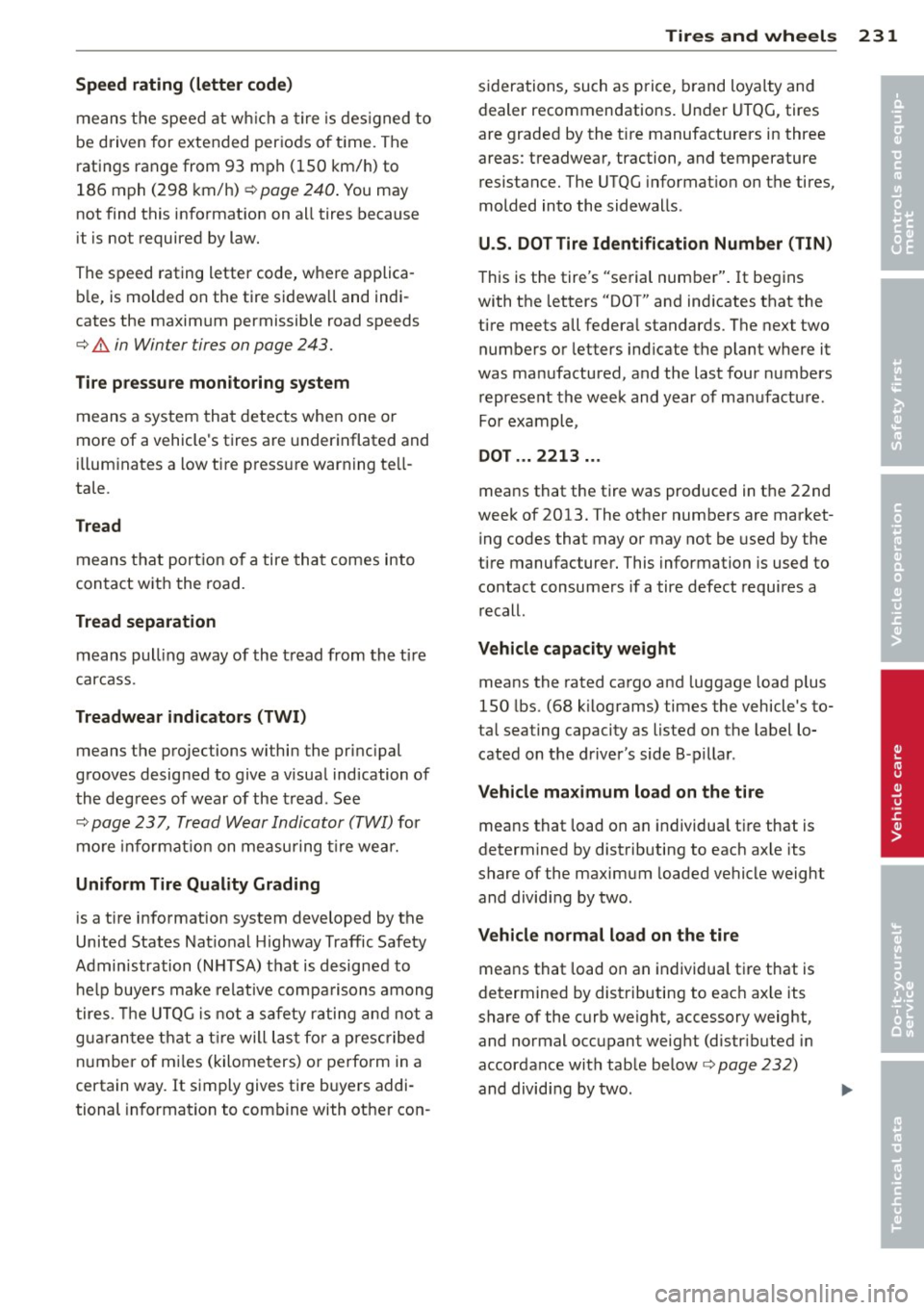
Speed rating (letter code)
means the speed at wh ich a tire is des igned to
be driven for extended periods of t ime . The
ratings range from 93 mph (150 km/h) to
186 mph (298 km/h) ¢
page 240 . You may
not find this information on all tires because
it is not required by law.
The speed rating letter code, where applica ble, is molded on the tire sidewall and indi
cates the maximum permissible road speeds
¢ &. in Winter tires on page 243.
Tire pressure monitoring system
means a system that detects when one or
more of a vehicle's tires are underinflated and
illuminates a low tire pressure warn ing te ll
tale .
Tread
means that portion of a tire that comes into
contact with the road.
Tread separation
means pulling away of the tread from the tire
carcass .
Treadwear indicators (TWI)
means the projections within the princ ipal
grooves designed to give a visual indication of
the degrees of wear of the tread. See
¢
page 237, Tread Wear Indicator (TWI) for
more informat ion on measuring tire wear.
Uniform Tire Quality Grading
is a tire information system developed by the
United States National Highway Traffic Safety
Admin istration (NHTSA) that is designed to
help buyers make relative comparisons among
tires . Th e U TQG is not a safety rating and not a
g ua ran tee that a tir e will las t for a prescribed
number of mi les (kilometers) or perform in a
certain way. It simply gives tire buyers addi
tional information to combine with other con-
Tires and wheels 231
siderations, such as price, brand loyalty and
dealer recommendations. Under UTQG, tires
are graded by the tire manufacturers in three
areas : treadwear, traction, and temperature
resistance. The UTQG informat ion on the tires,
molded into the sidewalls .
U.S. DOT Tire Identification Number (TIN)
This is the tire's "serial number". It begins
with the letters "DOT" and indicates that the
tire meets all federa l standards. The next two
numbers or letters ind icate the plant where it
was manufactured, and the last four numbers
represent the week and year of manufacture.
For example,
DOT ... 2213 ...
means that the tire was produced in the 22nd
week of 2013. The other numbers are market
ing codes that may or may not be used by the
tire manufacturer. This information is used to
contact consumers if a tire defect requires a
recall.
Vehicle capacity weight
means the rated cargo and luggage load p lus
150 lbs . (68 k ilograms) times the vehicle's to
tal seating capacity as listed on the label lo
cated on the driver's side B -pillar .
Vehicle maximum load on the tire
means that load on an individual tire that is
determined by distributing to each axle its
share of the maximum loaded vehicle weight
and dividing by two.
Vehicle normal load on the tire
means that load on an individual tire that is
determined by distributing to each ax le its
share of the curb weight, accessory weight,
and normal occupant weight (distr ibuted in
accordance with table below¢
page 232)
and dividing by two.
•
•
Page 242 of 292
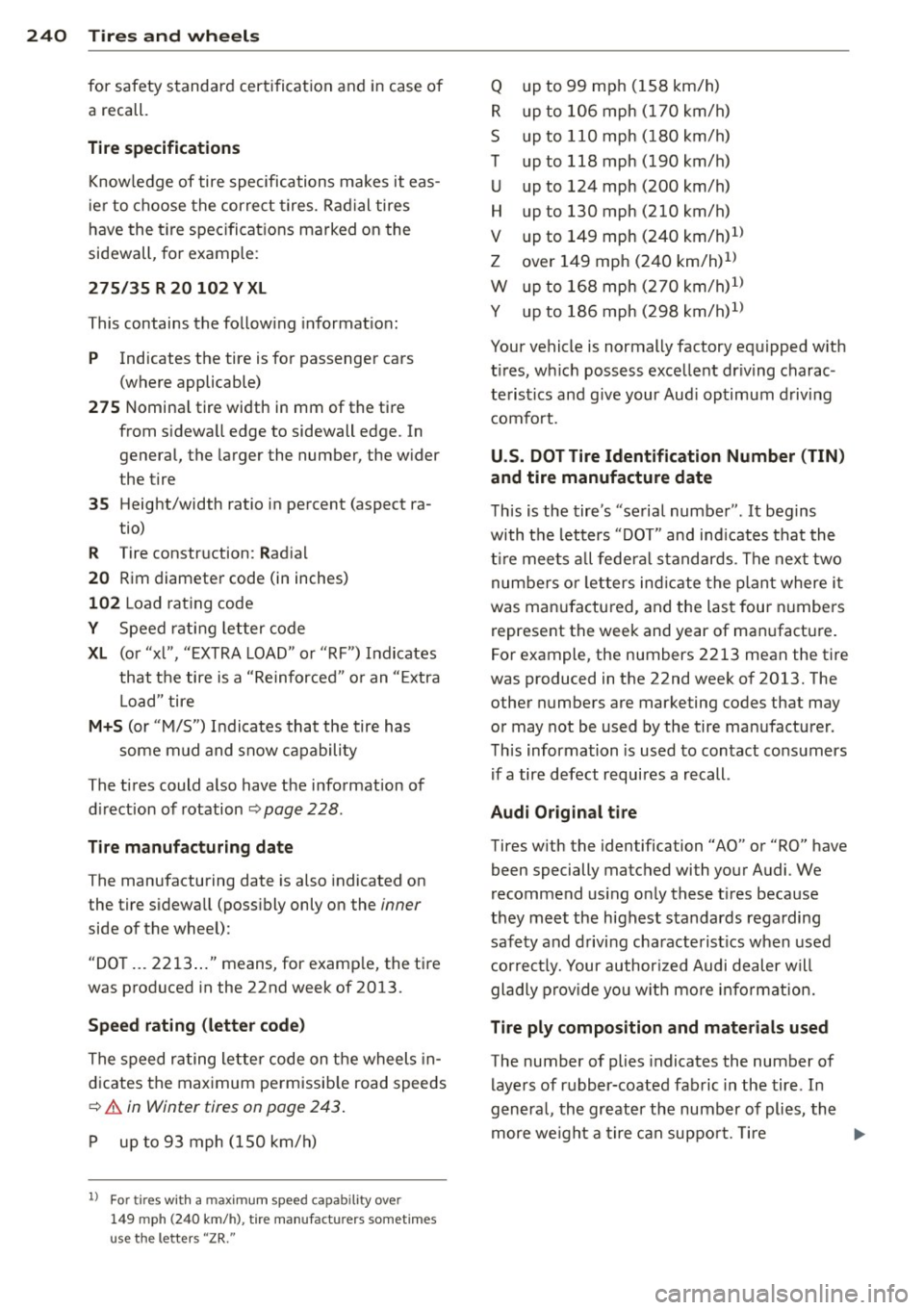
240 Tires and wheels
for safety standard certification and in case of
a recall.
Tire specifications
Knowledge of tire specifications makes it eas
ier to choose the correct tires. Radial tires
have the tire spec ifications marked on the
sidewall, for example:
275/35 R 20 102 Y XL
This contains the follow ing informat ion :
P Indicates the tire is for passenger cars
(where applicable)
275 Nominal tire width in mm of the tire
from sidewall edge to sidewall edge. In
general, the larger the number, the w ider
the tire
35 Height/width ratio in percent (aspect ra-
tio)
R Tire construction: Radia l
20 Rim diameter code (in inches)
102 Load rating code
Y Speed rat ing letter code
XL (or "xl", "EXTRA LOAD" or "RF") Indicates
that the tire is a "Reinforced " or an " Extra
L oad" tire
M+S (or "M/S") Indicates that the tire has
some mud and snow capability
The tires could also have the information of
d irection of rotation¢ page 228.
Tire manufacturing date
The manufacturing date is also indicated on
the tire s idewall (possibly only on the inner
side of the wheel):
"DO T ... 2213 ... " means, for examp le, the tire
was produced in the 22nd week of 2013.
Speed rating (letter code)
The speed rating letter code on the wheels in
dicates the maximum permissib le road speeds
¢ .&. in Winter tires on page 243.
P up to 93 mph (150 km/h)
ll For tires wit h a max imum speed capabil ity over
149 mph (240 km/h), tire manufactu rers somet im es
use the letters "ZR."
Q up to 99 mph (158 km/h)
R up to 106 mph ( 170 km/h)
s up to 110 mph ( 180 km/h)
T up to 118 mph ( 190 km/h)
u up to 124 mph (200 km/h)
H up to 130 mph (210 km/h)
V up to 149 mph (240 km/h)1l
z over 149 mph (240 km/h)1>
w up to 168 mph (270 km/h)1l
y up to 186 mph (298 km/h)1
)
Your vehicle is normally factory equipped w ith
t ir es, w hich possess excellent dr iving charac
teristics and g ive your Aud i optimum driving
comfort .
U.S. DOT Tire Identification Number (TIN)
and tire manufacture date
This is the tire's "serial number". It begins
with the letters "DOT" and ind icates that the
t ir e meets all federal standards . The next two
numbers or l etters ind icate the plant where it
was manufactu red, and the last four numbers
represent the week and year of man ufacture.
For example, the numbers 2213 mean the tire
was produced in the 22nd week of 2013. The
other numbers are marketing codes that may
or may not be used by the tire manufacturer.
This information is used to contact consumers
if a tire defect requires a recall.
Audi Original tire
Tires w ith the identification "AO" or "RO" have
been specially matched with your Audi. We
recommend using only these tires because
they meet the highest standards regarding
safety and driving characterist ics when used
correctly. Your authorized Audi dealer will
gladly provide you with more inf ormation.
Tire ply composition and materials used
The number of plies indicates the number of
layers of rubber-coated fabric in the tire. In
genera l, the greater the number of pl ies, the
more weight a tire can support. T ire
Page 243 of 292
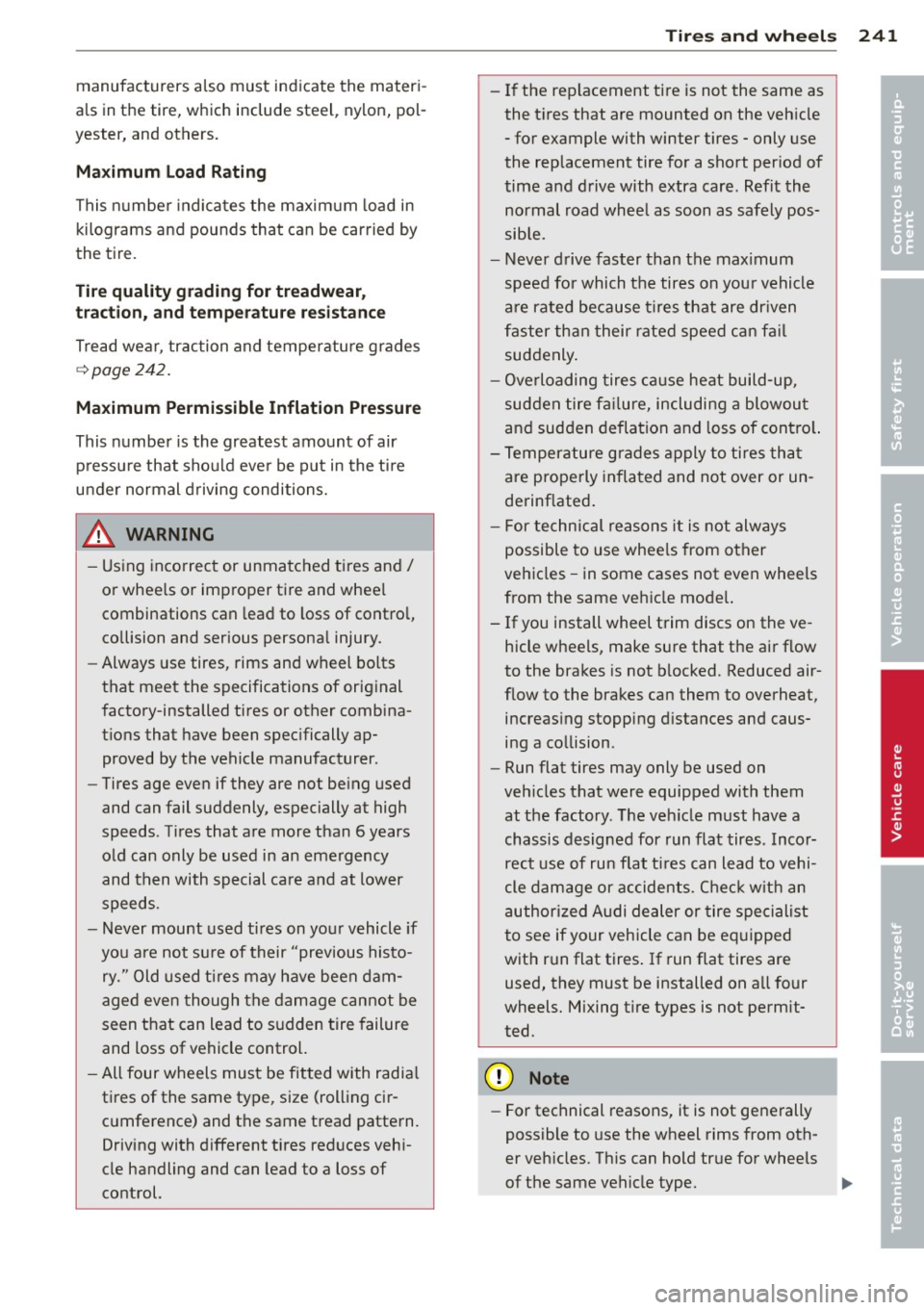
manufacturers also must indicate the materi
als in the tire, which include steel, nylon, pol
yester, and others.
M ax imum Load R atin g
This numbe r indicates the maximum load in
kilograms and pounds that can be carried by
the tire.
Tire qualit y gra ding for treadw ear,
t ract ion , and temp erature r esistanc e
Tread wear , traction and temperature g rades
¢ page 242.
Maximum Permissible Inflation Pressur e
This number is the greatest amount of air
pressure that sho uld ever be put in the ti re
under normal driving conditions.
_& WARNING ,...__._
- Using incorrect or unmatched tires and/
or whee ls or improper tire and whee l
combinations can lead to loss of contro l,
co llision and serious persona l injury.
- Always use tires, rims and wheel bo lts
that meet the specifications of original
factory-installed tires or other combina t ions that have been spec ifically ap
proved by the vehicle manufacturer.
- Tires age even if they are not being used
and can fail suddenly, especially at high
speeds . Tires that are more than 6 years
old can only be used in an emergency
and then with special care and at lower
speeds .
- Never mount used tires on your vehicle if
you are not su re of their "previous histo
ry." Old used ti res may have been dam
aged even though the damage cannot be
seen that can lead to s udden tire failure
and loss of vehicle control.
- All four wheels must be fitted with radia l
tires of the same type, size (rolling cir c u mference) and the same tread pattern.
Driving with different tires red uces veh i
cle handling and can lead to a loss of
control.
Tire s an d wheel s 241
-If the replacement tire is not the same as
the t ires that are mounted on the veh icle
- for example with winter tires - only use
the replacement tire for a short per iod of
time and drive with extra care . Refit the
normal road whee l as soon as safely pos
sible.
- Never drive faster than the max imum
speed for which the tires on you r vehicle
a re rated because tires that are dr iven
faster than thei r rated speed ca n fa il
suddenly .
- Ove rloading tires ca use heat build-up,
sudden tire fa ilure, including a blowou t
and sudden deflation and loss of cont ro l.
- Temperature grades apply to ti res that
are properly inflated and not over or un
derinf lated .
- F or technical reasons it is not always
possible to use whee ls from other
vehicles -in some cases not even whee ls
from the same veh icle mode l.
- If you install wheel trim discs on the ve
hicle wheels, make sure that the air flow
to the brakes is not b locked. Reduced air
flow to the brakes can them to overheat, increas ing stopping d istances and caus
ing a co llision.
- Run flat tires may only be used on
veh icles that were equipped with them
at the factory . The veh icle must have a
chassis designed for run flat tires . Incor
rect use of ru n flat ti res can lead to vehi
cle damage or accide nts. Che ck with an
author ized Audi dealer or tire spe cialist
to see if your vehicle can be eq uipped
with run flat tires . If run flat tires are
used, they must be installed on all four
wheels. Mixing tire types is not permit
ted.
@ Note
- For technical reasons, it is not generally
possible to use the wheel rims from oth
er veh icles. Th is can hold tr ue for wheels
of the same vehicle type. .,..
•
•
Page 244 of 292
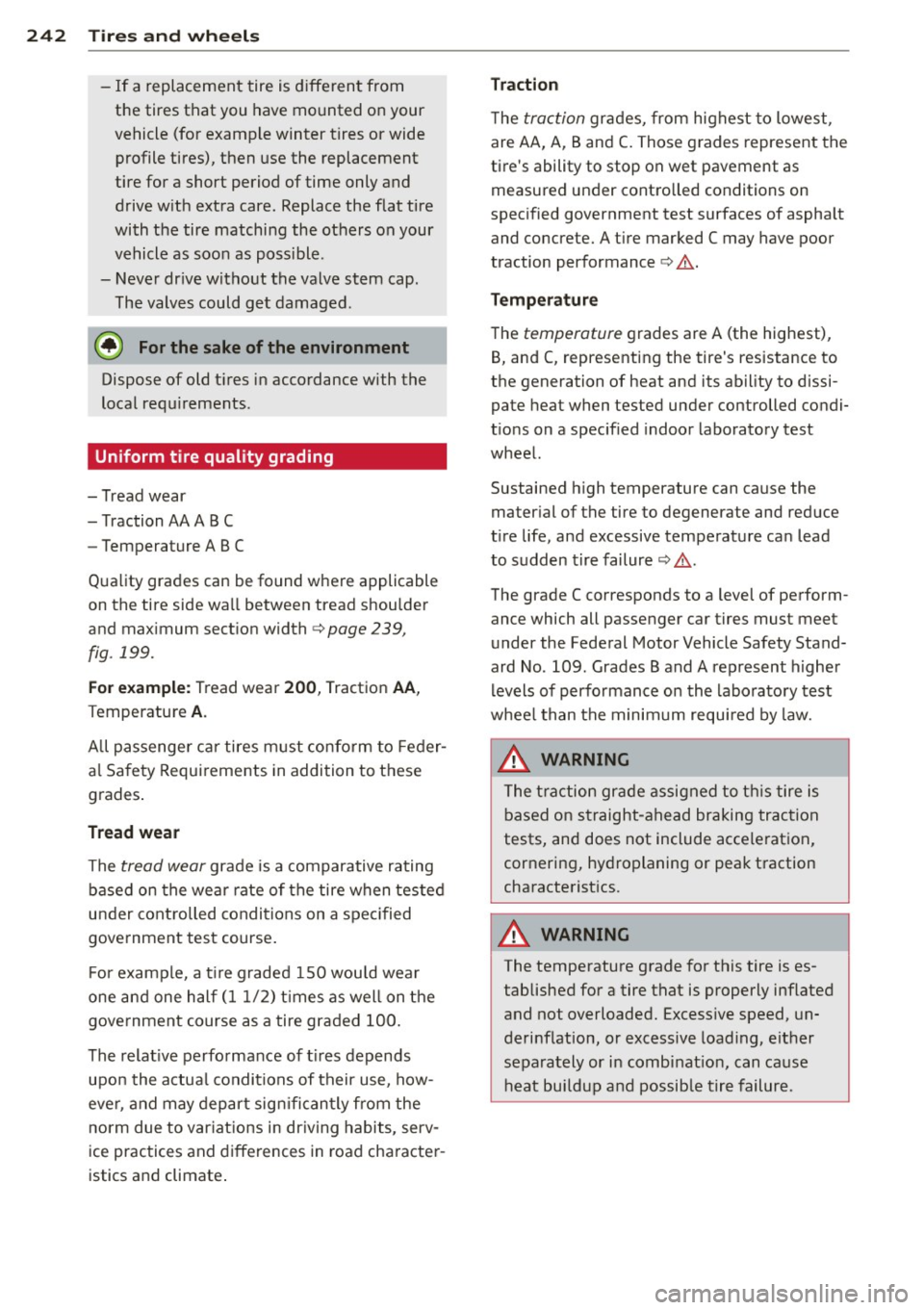
24 2 T ire s and wheel s
-If a replacement tire is different from
the tires that you have mounted on your
vehicle (for example winter tires or wide profile tires), then use the replacement
tire for a short period of time only and
drive w ith extra care. Replace the flat tire
with the tire matching the others on your
vehicle as soon as poss ible.
- Never dr ive without the valve stem cap .
The valves could get damaged.
@ For the sake of the environment
Dispose of old t ires in accordance with the
local requ irements.
Uniform tire quality grading
- Tread wear
- Traction AA A BC
- Temperature ABC
Quality grades can be found where applicable
on the tire side wa ll between tread shou lder
and max imum section width
¢ page 239,
fig. 199.
For example: Tread wear 200 , Traction AA,
Temperature A.
All passenge r car tires must confo rm to Feder
a l Safety Requirements in addition to these
grades .
Tread wear
The tread wear grade is a comparative rating
based on the wear rate of the tire when tested
u nder cont rolled conditions on a spec ified
government test course .
For example, a t ire graded 1S0 wou ld wear
one and one half (11/ 2) t imes as well on the
gove rnment course as a tire graded 100.
The relat ive perfo rmance of t ires depends
upon the a ctua l conditions of their use, how
ever, and may depart sign ifican tly from the
n orm due to var iat ions in dr iving habits, serv
ice practices and differences in road cha racte r
istics and climate .
Traction
The traction grades, from highest to lowest,
are AA, A, Band
C. Those grades represent the
ti re's ability to stop on wet pavement as
measured under contro lled conditions on
specified government test surfaces of aspha lt
and concrete. A t ire marked C may have poor
traction performance ¢.&,. .
Temperature
The temperature grades are A (the highest),
B, and C, representing the tire's resistance to
the generation of heat and its ab ility to dissi
pate heat when tested under controlled condi
t ions on a specif ied indoo r laboratory test
wheel.
Sustained h igh temperature can cause the
mater ial of the tire to degenerate and reduce
t ire life, and excessive temperature ca n lead
to sudden tire failure
~ .&,. .
The grade C corresponds to a level of perform
ance which all passenger car tires must meet
under the Federal Motor Vehicle Safety Stand
ard No. 109 . Grades Band A represent h igher
levels of performance on the laborato ry test
whee l than the minimum requ ired by law.
_& WARNING
The t raction grade assigned to t his tire is
based on s traight-ahead braking trac tion
tests, and does not include accelerat ion,
cornering, hydroplaning or peak t raction
cha racte rist i cs.
A WARNING "--
The temperature grade for this tire is es-
tablished for a tire that is properly inflated
and not overloaded. Excess ive speed, un
derinflation, or excess ive load ing, either
separately or in combinat ion, can cause
heat bui ldup and possib le tire failure.
-
Page 245 of 292
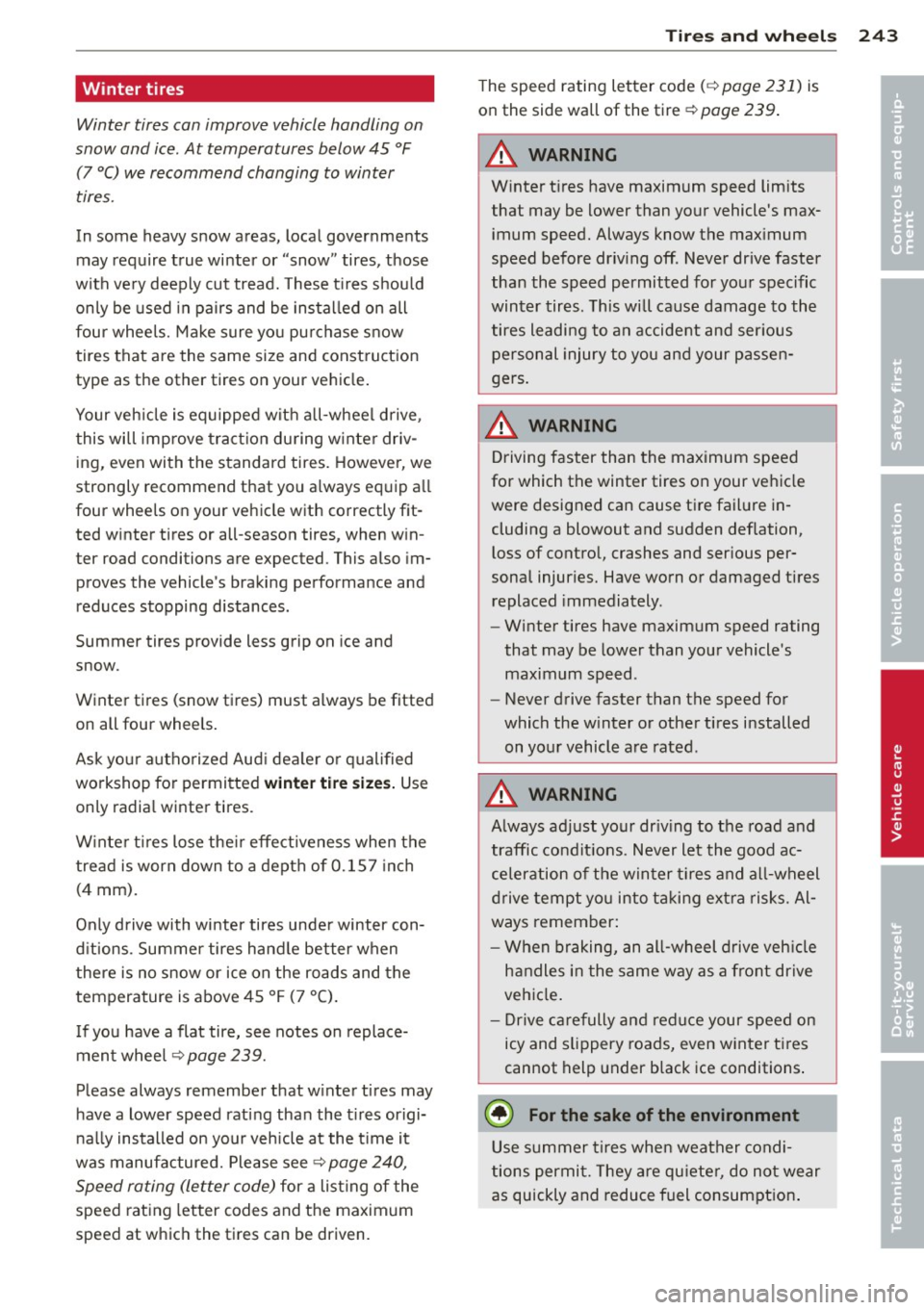
Winter tires
Winter tires can improve vehicle handling on
snow and ice . At temperatures below 45 °F
(7 °C) we r ecommend changing to winter
tires.
In some heavy s now areas, local governments
may require true winter or "snow " tires, those
with ve ry deeply cut tread. These t ires shou ld
only be used in pa irs and be insta lled on all
fou r wheels. Ma ke sure yo u pu rchase snow
tires that are the same size and construction
type as the other tires on your vehicle .
Your veh icle is equipped w it h all-wheel drive,
this will improve tra ct io n du ring w inte r driv
ing, even with the s tandard tires. However, we
strongly recommend that yo u always eq uip a ll
four whee ls on your vehicle with cor rectly fit
ted w inter tires or all-se ason tires, when w in
te r r oad conditions are expected . This also im
proves the vehicle's braking performance and
reduces stopping distances .
Summe r tires provide less grip on ice and
snow.
W inter t ires (snow t ires) must a lways be fitted
on all four whee ls .
Ask yo ur autho rized Aud i dea ler o r qualified
wo rkshop fo r permi tted
winter tire siz es . Use
on ly radia l winter tires.
W inte r tir es lose the ir effectiveness when the
tread is worn down to a depth of 0.15 7 inch
(4 mm) .
Only drive with wi nter tires under winter con
d it ions . Summer tires hand le better when
there is no snow or ice on the roads and the
temperature is above 45 °F ( 7 °C).
I f you have a flat tire, see notes on replace
men t wheel ¢
page 239.
Please always remember that w inter tires may
h ave a lower speed rating than the t ires origi
n a lly installed on your veh icle at the t ime it
was manufactured. Plea se see ~
page 240,
Speed rating (letter code)
for a List ing of the
speed rat ing letter codes and t he maxim um
speed at w hic h the tir es can be driven.
Tire s an d wheel s 243
The speed rating letter code(¢ page 231) is
o n the side wall of the tire~
page 239 .
A WARNING
Winter t ires have maximum speed limits
that may be lower than your vehicle's max
imum speed. Always know the max imum
speed before driv ing off . Never drive faster
than the speed permitted for yo ur specific
winter tires . This wi ll ca use damage to the
tires leadi ng to an accident and ser ious
personal injury to you and your passen
gers .
A WARNING ,._.__
Driving faster than the maximum speed
for which the winter tires on your vehicle
were designed can cause tire fail ure in
cluding a blowout and sudden deflation, loss of contro l, crashes and ser ious per
sonal injuries. Have worn or damaged tires
replaced immediately .
- Wi nter tires have maximum speed rating
that may be lower than your vehicle 's
maximum speed .
- Never drive faster than the speed for
which the w inter or othe r tires installed
on you r vehicle a re rated .
A WARNING
Always a djust yo ur dr iv ing to the road and
traffic cond it ions . Never let the good ac
celer atio n of the winter t ires and al l-wheel
d rive tempt yo u into ta king ext ra risks. Al
ways remember:
- W hen braking, an all-wheel drive veh icle
handles in the same way as a front drive
vehicle .
- Drive c arefully and reduce your speed on
icy and slippery roads, even w inter t ires
cannot help under black ice conditions .
@ For the sake of the environment
Use summer tires when weather condi
tions permi t. T hey are qu iete r, do not wear
as quickly and reduce fuel consumpt ion .
•
•
-